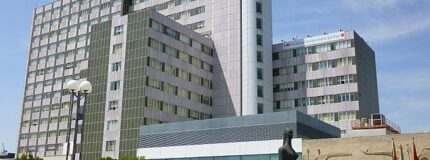How to contact the center
Full member
HCP Center

The Hospital Universitario La Paz is a public hospital, dependent on the Community of Madrid, located in the north of Madrid, which provides health care according to the census for around 500.000 inhabitants, however a wide number of complex patients are referred nationally for diagnosis and treatment.
The General Hospital was opened in July 1964 and in 1970 it became a teaching hospital in collaboration with Universidad Autonoma of Madrid. An important landmark in the history of this hospital was the creation of the transplant program in 1984. Since its opening, its physiognomy has changed and grown to become the great hospital complex we know today, with an infrastructure of more than 235.000 m2, consisting of a network of twenty buildings and four large hospitals: the General Hospital, the Maternal Hospital, the Children's Hospital and the Hospital of Traumatology and Rehabilitation. In 2005 the Hospital Cantoblanco and in 2013 the Hospital Carlos III were integrated in the network.
The Hospital Universitario La Paz is recognised as a centre of reference and health excellence, a recognition that extends both to its healthcare activity and to its teaching and research activity. The Children Hospital is the only centre in Spain which counts with all the medical and surgical subspecialties to take care of paediatric patients. The Children Hospital is centre of national reference for twenty-five pathologies, amongst which six concern the Ophthalmology Department: Congenital Malformations of the ocular globe and eyelids, Extraocular Paediatric Tumors (rabdomiosarcoma), Intraocular Paediatric Tumors (retinoblastoma), Advanced Premature Retinopathy, Paediatric Penetrant Keratoplasty and Bullous Epidermolysis.
In order to understand the dimensions of this large hospital, it is necessary to bear in mind its volume of healthcare activity. In 2015, the Hospital Universitario La Paz treated more than 46,000 patients in its hospitalization plants and more than 218,000 patients in its emergency services. It has attended more than one million outpatient consultations and has performed 55,000 surgeries in its facilities, some of great technical complexity such as the different types of transplants that are performed in this centre.To reach this volume of activity the Hospital Universitario La Paz has a team of around 7,400 professionals, a large infrastructure and all the necessary high-tech equipment and diagnostic tests. It provides a multidisciplinary approach for a vast number of diseases, works hand to hand with the Genetic and Molecular Diseases Department and IdiPaz (biomedical investigation organisation).
The General Hospital was opened in July 1964 and in 1970 it became a teaching hospital in collaboration with Universidad Autonoma of Madrid. An important landmark in the history of this hospital was the creation of the transplant program in 1984. Since its opening, its physiognomy has changed and grown to become the great hospital complex we know today, with an infrastructure of more than 235.000 m2, consisting of a network of twenty buildings and four large hospitals: the General Hospital, the Maternal Hospital, the Children's Hospital and the Hospital of Traumatology and Rehabilitation. In 2005 the Hospital Cantoblanco and in 2013 the Hospital Carlos III were integrated in the network.
The Hospital Universitario La Paz is recognised as a centre of reference and health excellence, a recognition that extends both to its healthcare activity and to its teaching and research activity. The Children Hospital is the only centre in Spain which counts with all the medical and surgical subspecialties to take care of paediatric patients. The Children Hospital is centre of national reference for twenty-five pathologies, amongst which six concern the Ophthalmology Department: Congenital Malformations of the ocular globe and eyelids, Extraocular Paediatric Tumors (rabdomiosarcoma), Intraocular Paediatric Tumors (retinoblastoma), Advanced Premature Retinopathy, Paediatric Penetrant Keratoplasty and Bullous Epidermolysis.
In order to understand the dimensions of this large hospital, it is necessary to bear in mind its volume of healthcare activity. In 2015, the Hospital Universitario La Paz treated more than 46,000 patients in its hospitalization plants and more than 218,000 patients in its emergency services. It has attended more than one million outpatient consultations and has performed 55,000 surgeries in its facilities, some of great technical complexity such as the different types of transplants that are performed in this centre.To reach this volume of activity the Hospital Universitario La Paz has a team of around 7,400 professionals, a large infrastructure and all the necessary high-tech equipment and diagnostic tests. It provides a multidisciplinary approach for a vast number of diseases, works hand to hand with the Genetic and Molecular Diseases Department and IdiPaz (biomedical investigation organisation).
Contact
Hospital Universitario La Paz, Spain
Paseo de la Castellana, 261
28046 Madrid
Spain
Team

Dr Susana Noval
Representative
Spain
Low Vision Daily Life and Patients Groups (TWG5), National Integration (TWG9), Neuro-Ophthalmology Rare Diseases (WG2), Pediatric Ophthalmology Rare Diseases (WG3), Research (TWG8), Retinal Rare Eye Diseases (WG1)
Working Group Leader

Dr María Nieves-Moreno
Spain
CPMS & Digital Medecine (TWG10), National Integration (TWG9), Pediatric Ophthalmology Rare Diseases (WG3), Research (TWG8), Retinal Rare Eye Diseases (WG1)

Dr Elena Vallespín
Spain
Genetic Diagnostics (TWG6), National Integration (TWG9), Pediatric Ophthalmology Rare Diseases (WG3), Registries & Epidemiology (TWG7), Research (TWG8), Retinal Rare Eye Diseases (WG1)

Dr Ana Boto
Spain
Anterior Segment Rare Eye Diseases (WG4), National Integration (TWG9), Research (TWG8)

Dr Jesús Fraile
Spain
Neuro-Ophthalmology Rare Diseases (WG2), Pediatric Ophthalmology Rare Diseases (WG3)

Marta Guerrero
Spain
Low Vision Daily Life and Patients Groups (TWG5), National Integration (TWG9)

Dr Jesús Peralta-Calvo
Spain
CPMS & Digital Medecine (TWG10), Pediatric Ophthalmology Rare Diseases (WG3)

Dr Fernando Santos-Simarro
Spain
Genetic Diagnostics (TWG6), National Integration (TWG9), Pediatric Ophthalmology Rare Diseases (WG3), Registries & Epidemiology (TWG7), Research (TWG8)
Clinical trials

NCT05566795 - Recruiting, Active
A Phase 3, Randomized, International Multicenter Trial of DAY101 Monotherapy Versus Standard of Care Chemotherapy in Patients with Pediatric Low-Grade Glioma Harboring an Activating RAF Alteration Requiring First-Line Systemic Therapy
Interventional

NCT05408715 - Recruiting, Active
An International Prospective Natural History Study in Children With a Type II Collagen Disorder With Short Stature
Observational

NCT04088409 - Active, Not recruiting
An Open-label, Active-Controlled, Safety, and Efficacy Study of Oral Baricitinib in Patients From 2 Years to Less Than 18 Years Old With Active Juvenile Idiopathic Arthritis-Associated Uveitis or Chronic Anterior Antinuclear Antibody-Positive Uveitis
Interventional


